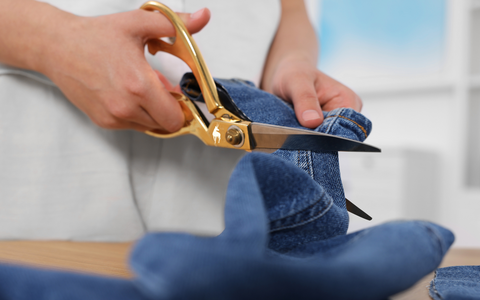Hemming your pants may sound like a simple task, but if you've ever tried it, you know that it's not as easy as it seems. Whether your pants are just a bit too long or you want to achieve a specific look, getting them hemmed by a tailor can make a huge difference. In this guide, we’ll walk you through the process of hemming your pants at a tailor, explain why a tailor's expertise is important, and how to make sure you get the perfect fit.
Why Hemming Is Important
Pants that are too long can make you look sloppy, while pants that are too short may look awkward. Having your pants hemmed to the perfect length can elevate your overall appearance and boost your confidence. Hemming ensures your pants fit well, sit correctly on your shoes, and give you that polished, professional look.
What Does It Mean to Hem Pants?
Hemming is simply the process of adjusting the length of your pants. It involves cutting off excess fabric and sewing a new hem to make sure the pants hit your legs at the right spot. Hemming can be done on all types of pants—jeans, dress pants, or even casual trousers.
While some people choose to hem their own pants, taking them to a tailor ensures a precise, professional finish. A tailor not only knows how much fabric to cut but also has the tools to make the hem sturdy and long-lasting.

The Importance of a Tailor
A tailor’s job goes beyond basic clothing alterations. They can transform the way your clothes fit and make you look your best. Here’s why going to a tailor is worth it:
-
Professional Results: A tailor has the experience and skills to make precise adjustments. If you try to hem your pants yourself, you might end up with uneven or crooked seams. A professional tailor will make sure the hem is straight and secure, giving your pants a neat, finished look.
-
Customized Fit: Everyone’s body is different, and a tailor knows how to adjust your clothing to fit your unique shape. Whether your legs are short, long, or somewhere in between, a tailor will ensure the hem is exactly where it needs to be.
-
Saves Time and Stress: Hemming pants yourself can take time and might require multiple attempts to get it right. Taking your pants to a tailor saves you the hassle, and you’ll get them back with a professional finish.
-
Preserving Quality: Tailors are skilled in working with various fabrics. If you’re hemming expensive dress pants or delicate fabrics, a tailor knows how to handle them without causing damage. They can also match the original stitching style to keep your pants looking like new.
How to Work with a Tailor to Hem Your Pants
If you're ready to get your pants hemmed, follow these steps to make sure you and your tailor are on the same page.
1. Find the Right Tailor
Start by finding a good tailor in your area. Ask for recommendations from friends or family, or check online reviews. Once you find a tailor, you can give them a call or visit their shop to discuss your needs.
2. Try on Your Pants
When you visit the tailor, bring the shoes you plan to wear with the pants. This is important because the height of your shoes will affect how long your pants should be. Put on your pants and the shoes, and the tailor will measure how much fabric needs to be removed.
3. Decide on the Length
Tell the tailor how long you want your pants to be. For dress pants, you may want them to lightly touch the top of your shoes. For casual pants, a slightly shorter length might be more appropriate. Tailors often ask if you want a "break" in your pants, which means how much the fabric rests on your shoes. A full break means the fabric bunches slightly at the top of your shoes, while no break means the hem just touches your shoe without any bunching.
4. Discuss the Hem Style
There are different ways to hem pants, depending on the look you’re going for. For dress pants, a blind hem is common. This type of hem has no visible stitching, giving it a clean finish. For jeans or more casual pants, you might want a regular hem with visible stitching. Your tailor can guide you through the options and help you choose the best style for your pants.
5. Check the Fit
Once the tailor pins the pants to the desired length, you’ll get a chance to check how they look. Walk around, sit down, and make sure the length feels comfortable. If something doesn’t seem right, don’t hesitate to speak up. A good tailor will make sure you’re happy with the fit before making any final cuts.
6. Pick Up Your Hemmed Pants
After the hemming is complete, your tailor will call you to pick up your pants. Be sure to try them on again before leaving the shop to ensure everything looks perfect.

Common Types of Pant Hems
There are a few common types of pant hems that you can choose from, depending on your style and the type of pants you’re hemming:
- Blind Hem: This is often used for dress pants. The stitches are hidden, giving a clean and polished look.
- Regular Hem: This hem has visible stitching and is typically used for casual pants or jeans.
- Cuffed Hem: A cuffed hem folds the fabric up at the bottom of the pants, creating a visible cuff. It’s often used for dress pants and gives a more formal appearance.
When Should You Hem Your Pants?
You should hem your pants when they’re too long or don’t fit properly at the bottom. Some common signs that your pants need hemming include:
- The fabric pools around your feet when you walk.
- Your pants drag on the ground.
- The hemline looks uneven.
Hemming is also a great way to refresh an old pair of pants. If you’ve lost or gained weight, hemming can help you achieve a better fit.
Final Thoughts on Hemming Your Pants
Hemming your pants at a tailor can be a game-changer for your wardrobe. It’s a small adjustment that can make a big difference in how your clothes look and feel. By working with a professional tailor, you’ll ensure your pants are the perfect length, fit your body well, and have a polished, finished look.
So next time you find yourself with pants that are just a bit too long, don’t hesitate to visit a tailor. You’ll be glad you did!

0 comments